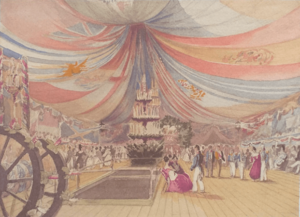HMS Dublin (1812) facts for kids

Dublin
|
|
Quick facts for kids History |
|
|---|---|
| Name | Dublin |
| Ordered | 31 July 1807 |
| Builder | Brent, Rotherhithe |
| Laid down | May 1809 |
| Launched | 13 February 1812 |
| Fate | Sold, 1885 |
| General characteristics | |
| Class and type | Vengeur-class ship of the line |
| Tons burthen | 1772 bm |
| Length | 176 ft (53.6 m) (gundeck) |
| Beam | 47 ft 6 in (14.5 m) |
| Depth of hold | 21 ft (6.4 m) |
| Propulsion | Sails |
| Sail plan | Full-rigged ship |
| Armament |
|
HMS Dublin was a large and powerful sailing warship. It belonged to the Royal Navy of the United Kingdom. This ship was known as a "74-gun third rate ship of the line." This meant it was one of the biggest warships of its time. It had 74 cannons on its decks. The ship was launched on February 13, 1812, in a place called Rotherhithe.
Contents
What Was a Ship of the Line?
A "ship of the line" was a huge warship. It was designed to fight in a battle line. This was a tactic where ships sailed in a row. They would fire their cannons at enemy ships. These ships were the most important warships of their era. They were like the battleships of today.
A "third rate" ship meant it had between 64 and 80 guns. HMS Dublin had 74 guns. This made it a very strong ship.
Early Adventures and Captures
HMS Dublin was involved in some interesting events. On July 17, 1813, Dublin helped capture a ship named Union. Dublin shared the money from this capture with another ship, HMS Abercrombie.
Later, on December 19, 1812, a ship called HMS Rolla recaptured a whaler (a ship that hunted whales) named Frederick. Dublin also shared in the "salvage money" for Frederick. Salvage money is a reward given to ships that help save or recover other ships or their cargo.
Changes and Important Roles
In 1826, HMS Dublin was changed. It was "reduced" to a 40-gun ship. This meant some of its cannons were removed. It became a smaller, but still important, warship.
From 1835 to 1838, Dublin served as the "flagship" for Admiral Sir Graham Hamond, 2nd Baronet. A flagship is the ship that carries the admiral. It is where the admiral's flag is flown. It acts as the main command center for a fleet. Admiral Hamond was the Commander-in-Chief of the Pacific fleet. This means he was in charge of all the Royal Navy ships in the Pacific Ocean.
Later, from 1841 to 1845, Dublin was the flagship for Rear Admiral Richard Darton Thomas.
End of Service
After many years of service, HMS Dublin was no longer needed by the Royal Navy. In 1885, the ship was "sold out of the Navy." This means it was sold to someone else and was no longer part of the Royal Navy fleet.


